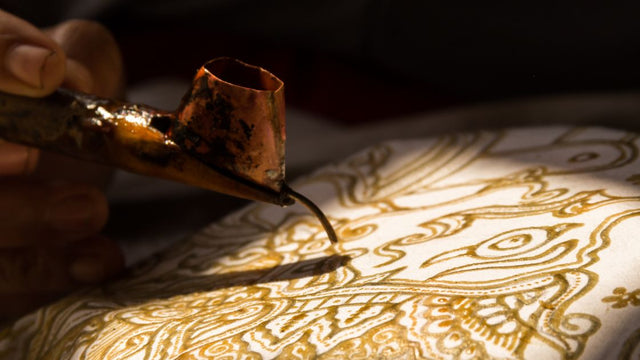Traditional Batik: Indonesia's Ancient Textile Heritage
Batik is not merely a form of textile; it is a profound representation of Indonesian textile heritage forged through centuries of craftsmanship. Characterised by its exquisite designs, the art of batik relies on a meticulous wax resist dyeing technique, where artisans apply hot wax to fabric, creating intricate patterns. The term 'batik' originates from the Javanese word 'bathik', emphasising its deep cultural roots in Java.
This unique practice has existed since as early as 5000 BC, with the oldest known batik textile discovered in Toraja Regency, Sulawesi island, dating back to the 5th century. Acknowledged by UNESCO as a Masterpiece of the Oral and Intangible Cultural Heritage of Humanity in 2009, batik serves as a testament to the cultural significance that permeates through the generations. Each piece not only tells its own story but also reflects the beliefs and social hierarchies of the communities it represents.
The importance of batik extends beyond Indonesia, fostering connections among Southeast Asian nations such as Malaysia and Thailand since the 19th century. As a core livelihood for many, batik has become the backbone for thousands of small-medium enterprises across Indonesia, showcasing the enduring appeal and relevance of this ancient craft.

Key Takeaways
- Batik has existed for over 7000 years, showcasing an enduring artisanal tradition.
- It is recognised by UNESCO due to its exceptional cultural values and historical significance.
- Each batik motif reflects local traditions, beliefs, and social meanings.
- The wax resist dyeing technique highlights the intricate artistry involved in batik production.
- Batik serves as a vital link between the cultural practices of various Southeast Asian nations.
- It remains an essential craft for thousands of artisans, underpinning local economies.
The Art and Significance of Batik Tradisional
The intricate world of batik tradisional showcases two primary techniques: batik tulis, which employs hand-drawn designs, and batik cap, where copper stamps are utilised for faster production. The significance of batik extends beyond mere aesthetics; it encapsulates cultural heritage and artistic expression intertwined with Indonesian identity.
Understanding the Batik Technique
At the core of seni batik lies the traditional method of wax-resist dyeing. This artistry can absorb extensive periods, often ranging from one month to two years, depending on the intricacy of the designs. Artisans use a canting tool, characterised by its delicate spouts, to apply wax on fabric for batik tulis or a cap for batik cap. This process allows craftsmen to achieve a diverse array of patterns and textures that reflect their surroundings and histories.
Cultural and Historical Importance
Batik traditions are steeped in rich cultural significance, particularly in Java, where it developed as an esteemed art form. Historically, the art was reserved for royalty and held specific symbolic meanings, especially in ceremonial contexts. The application of the wax and dye process exemplifies the craftsmanship passed down through generations. Notably, motifs often carry profound meanings, such as the Sidomulyo, which represents honour and is frequently associated with royal weddings.
Exploring Motif Batik and Their Unique Symbolism
The intricate world of motif batik offers a glimpse into the profound cultural identity in batik, showcasing a rich tapestry of history, symbolism, and artistry. Each motif holds its own narrative, embodying the values, beliefs, and aspirations of various Indonesian communities. Distinct patterns not only serve as a form of artistic expression but also reveal the rich cultural heritage of batik Indonesia.
Common Motifs in Batik
Among the numerous patterns utilised in batik, certain motifs stand out for their symbolic meanings:
- Kawung: A motif representing self-control and purity, historically associated with moral education.
- Pudak Sawo: Signifying hope and prosperity, this motif is cherished for its uplifting connotation.
- Parang: Often expressing strength and power, this geometric design is widely recognised in traditional batik.
Each of these motifs highlights the intricate relationship between art and the cultural identity in batik, offering layers of meaning that deepen our understanding of Indonesian artistry.
Regional Variations
Batiks across different regions in Indonesia showcase unique characteristics influenced by the local culture and environment. For instance:
- Yogyakarta Batik: Known for its elegant designs, it reflects the traditional values of the royal families.
- Pekalongan Batik: This region is characterised by vibrant colours and motifs that communicate the lively spirit of coastal life.
- Cirebon Batik: Integrating Chinese and Arab influences, this style embodies rich symbolism and narrative depth.
The diversity in motif batik not only enriches Indonesia's cultural landscape but also underscores the significance of regional identity within the broader narrative of batik as an art form. The preservation of these diverse styles plays a crucial role in maintaining the cultural identity in batik, ensuring that each design remains a testament to the nation's heritage.
Conclusion
Batik, an ancient dyeing technique, continues to stand as a significant pillar of Indonesia's cultural heritage, embracing a rich history that spans over 1,500 years. Not only is it celebrated for its intricate designs and skilled craftsmanship, but it also serves as a vital connection to the past. The preservation of batik is crucial in maintaining its integrity and ensuring that future generations can appreciate this unique art form. Efforts by local artisans, communities, and organisations are pivotal in adapting batik traditions to contemporary contexts, thereby appealing to modern tastes while honouring its deep-rooted significance.
The future of batik tradisional is increasingly bright, marked by innovation and global recognition. As designers blend traditional motifs with contemporary styles, batik is being resituated within the global fashion framework, engaging both locals and international audiences alike. Furthermore, the banking industry’s involvement has provided much-needed financial support, empowering batik entrepreneurs to thrive and adapt in an ever-changing market.
As the world continues to embrace the spirit of batik, it is imperative that the significance of its preservation remains a priority. By safeguarding this cultural heritage, we not only honour the craftsmanship and artistry of the past but also cultivate a vibrant future for batik, ensuring its ongoing evolution and relevance in a globalised world.


